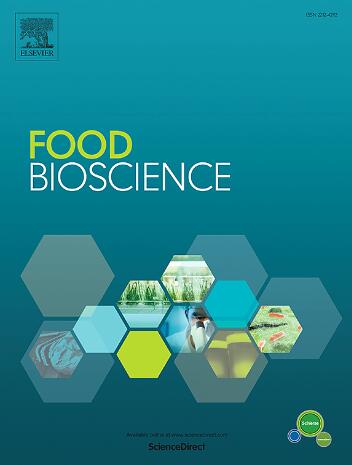基于HS-SPME-GC-MS、HPLC和电子鼻技术评价15份天麻种质资源品质特征
IF 4.8
1区 农林科学
Q1 FOOD SCIENCE & TECHNOLOGY
引用次数: 0
摘要
天麻是一种药食同源植物,具有重要的经济和药用价值;然而,目前的种质鉴定方法仍然相对简单。采用高效液相色谱(HPLC)、电子鼻(E-nose)、顶空固相微萃取-气相色谱-质谱联用技术(HS-SPME-GC-MS)对15份中国产白杨种质的酚类和风味成分进行了综合分析。HPLC分析确定了3个关键的酚类标记物:天麻素(0.05% ~ 0.64%)、4-羟基苄基醇(区域差异显著)和巴利辛E(0.57% ~ 1.26%)。电子鼻分析结果显示,不同叶红种质间的气味差异主要通过W1W(传感器响应值为29.65)、W2W(传感器响应值为11.18)和W5S(传感器响应值为12.11)传感器检测。主成分分析(PCA)有效区分了8个区域的15个样本。HS-SPME-GC-MS分析鉴定出43种特征挥发物。4-甲氧基甲基苯酚(0 % - 0.28%)、(E)-3-苯丙-2-烯酸(0 % - 1.37%)、环十二烷(0 % - 0.31%)、十一烷基环戊烷(0 % - 0.60%)和3-甲基十七烷(0 % - 0.95%)被认为是种质分化的鉴别标记,而十六烷酸(7.84% - 16.71%)被认为是普遍的香气成分。此外,本研究还揭示了不同elata变种中独特的差异成分,如elata bla . f. elata中(Z,Z)-十八烷-9,12-二烯酸(3.80% ~ 6.78%),elata bla . f. elata中2,4-二叔丁基苯酚(1.48% ~ 10.09%)和elata bla . f. viridis中十六酸甲酯(0.53% ~ 2.74%)。通过建立龙葵的多维鉴定框架,阐明龙葵的地球化学关系,为龙葵的质量评价、真伪鉴定和品种选择提供科学依据。本文章由计算机程序翻译,如有差异,请以英文原文为准。
Evaluation of quality characteristics of 15 Gastrodia elata germplasm resources based on HS-SPME-GC-MS, HPLC and electronic nose techniques
As a medicinal-food homologous plant, Gastrodia elata (G. elata) possesses significant economic and medicinal value; however, current germplasm identification methods remain relatively simplistic. This study integrated High-Performance Liquid Chromatography (HPLC), Electronic Nose (E-nose), and Headspace Solid-Phase Microextraction coupled with Gas Chromatography-Mass Spectrometry (HS-SPME-GC-MS) to comprehensively analyze the phenolic and flavor profiles of 15 G. elata germplasms from China. HPLC analysis identified three key phenolic markers: gastrodin (0.05 %–0.64 %), 4-hydroxybenzylalcohol (with significant regional differences), and parishin E (0.57 %–1.26 %). E-nose analysis revealed that odor differences between G. elata germplasm were primarily detected by the W1W (Sensor response: 29.65), W2W (Sensor response: 11.18), and W5S (Sensor response: 12.11) sensors. Principal component analysis (PCA) effectively distinguished the 15 samples from 8 regions. HS-SPME-GC-MS analysis identified 43 characteristic volatiles. 4-Methoxymethylphenol (0 %–0.28 %), (E)-3-phenylprop-2-enoic acid (0 %–1.37 %), cyclododecane (0 %–0.31 %), undecylcyclopentane (0 %–0.60 %), and 3-methylheptadecane (0 %–0.95 %) emerged as discriminative markers for germplasm differentiation, while hexadecanoic acid (7.84 %–16.71 %) identified as a universal aroma component. Furthermore, this study revealed unique differential components in various G. elata variants, such as (Z,Z)-octadeca-9,12-dienoic acid (3.80 %–6.78 %) in G. elata Bl. f. elata, 2,4-di-tert-butylphenol (1.48 %–10.09 %) and methyl hexadecanoate (0.53 %–2.74 %) in G. elata Bl. f. viridis. By establishing a multidimensional identification framework for G. elata, this study elucidates the geo-chemical relationships and provides a scientific foundation for quality assessment, authenticity verification, and cultivar selection.
求助全文
通过发布文献求助,成功后即可免费获取论文全文。
去求助
来源期刊

Food Bioscience
Biochemistry, Genetics and Molecular Biology-Biochemistry
CiteScore
6.40
自引率
5.80%
发文量
671
审稿时长
27 days
期刊介绍:
Food Bioscience is a peer-reviewed journal that aims to provide a forum for recent developments in the field of bio-related food research. The journal focuses on both fundamental and applied research worldwide, with special attention to ethnic and cultural aspects of food bioresearch.
 求助内容:
求助内容: 应助结果提醒方式:
应助结果提醒方式:


